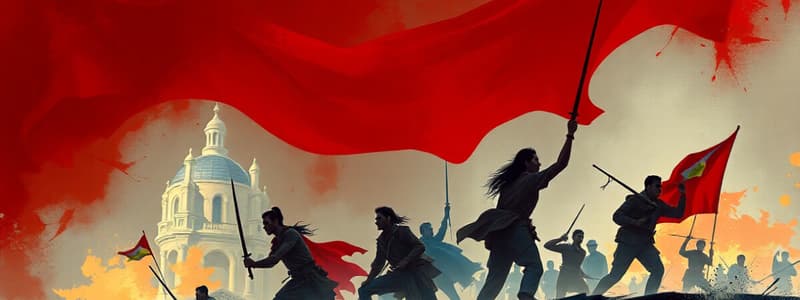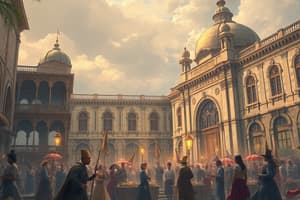Podcast
Questions and Answers
Which individual is falsely associated with the Cavite uprising due to the impact of Freemasonry on his decisions?
Which individual is falsely associated with the Cavite uprising due to the impact of Freemasonry on his decisions?
- Trinidad Pardo de Tavera
- Carlos Ma. Dela Torre
- Edmund Plauchut
- Rafael de Izquierdo (correct)
Which of the following statements about the Cadiz Constitution is correct?
Which of the following statements about the Cadiz Constitution is correct?
- It permanently resolved conflicts between the Liberales and Serviles.
- It had no effect on the political situation in the Philippines.
- It strengthened the power of local governance in the Philippines.
- It was acknowledged but later dismissed. (correct)
What factor did T.H. Pardo de Tavera highlight as influencing the friars' alignment of the Cavite uprising to revolution?
What factor did T.H. Pardo de Tavera highlight as influencing the friars' alignment of the Cavite uprising to revolution?
- The influence of local Filipino leaders.
- The decline of the Spanish military.
- The execution of GOMBURZA.
- Involvement of Senator Segismundo Moret. (correct)
Which statement regarding the acknowledgement of a Catholic mass in Butuan is true?
Which statement regarding the acknowledgement of a Catholic mass in Butuan is true?
Which of the following statements is incorrect about the implications of the Cavite uprising?
Which of the following statements is incorrect about the implications of the Cavite uprising?
What is the primary message conveyed in Pag-ibig sa Tinubuang Bayan by Andres Bonifacio?
What is the primary message conveyed in Pag-ibig sa Tinubuang Bayan by Andres Bonifacio?
What was the role of the Tejeros Convention in the political landscape of the period?
What was the role of the Tejeros Convention in the political landscape of the period?
Which statement about the Cry of Independence and its historical context is accurate?
Which statement about the Cry of Independence and its historical context is accurate?
Which idea closely aligns with the first stanza of Pag-ibig sa Tinubuang Bayan by Andres Bonifacio?
Which idea closely aligns with the first stanza of Pag-ibig sa Tinubuang Bayan by Andres Bonifacio?
How did the turbulent rule of Ferdinand VII during the 19th century affect his political decisions?
How did the turbulent rule of Ferdinand VII during the 19th century affect his political decisions?
Flashcards are hidden until you start studying
Study Notes
Cavite Mutiny and Andres Bonifacio
-
The Cavite Mutiny (1872) was a military uprising in the Philippines that was brutally suppressed by the Spanish colonial government. The rebellion was sparked by several factors, including resentment towards Spanish rule, dissatisfaction with the friars' influence, and discriminatory policies against Filipinos in the military.
-
The rebellion involved two main factions: the Magdiwang (led by Mariano Alvarez) and the Magdalo (led by Baldomero Aguinaldo).
-
The headquarters of the Magdiwang faction was in Kawit, while the headquarters of the Magdalo faction was in Noveleta.
-
The uprising was quickly put down by Spanish forces due to a misunderstanding concerning the firing of fireworks.
-
The execution of the three Filipino priests (GOMBURZA)—Mariano Gomez, Jose Burgos, and Jacinto Zamora—was seen by many Filipinos as an injustice and fueled anti-Spanish sentiment.
-
Governor General Rafael de Izquierdo was responsible for the aftermath of the mutiny, imposing different punishments for those deemed guilty. His actions were influenced by alleged Freemasonry involvement.
-
The Cavite mutiny was linked to the broader Filipino nationalist movement by some historians like T.H. Pardo de Tavera.
-
The execution of GOMBURZA and the subsequent events of the Cavite mutiny are significant because they ignited a stronger anti-Spanish sentiment among Filipinos.
Katipunan and The Cry of Independence
-
The Katipunan was a revolutionary society established in the Philippines in 1892.
-
The Katipunan was inspired by Freemasonry and aimed to liberate the Philippines from Spanish rule.
-
The tearing of the cedula (identity card) by Andres Bonifacio signaled an all-out war against Spain.
-
The Cry of Independence is a pivotal event in Philippine history, signifying the start of the Philippine Revolution against Spain.
-
The Cry of Independence, proclaimed by Andres Bonifacio and the Katipunan, aimed for the independence of the Philippines from Spain.
-
There is ongoing debate about the exact date, location, and events surrounding the Cry of Independence, with different accounts claiming it to be in Balintawak or Pugad Lawin.
-
Notable figures involved in the Cry include Andres Bonifacio, Emilio Jacinto, and other Katipunan leaders.
-
The term “Haring Bayan” ("King of the Nation") was used by the Katipunan to refer to their leadership.
-
The Katipunan was primarily led by Andres Bonifacio, with "Katagalugan" (Tagalog region) acting as their stronghold.
Key Figures and Writings
-
Andres Bonifacio remains a significant figure in Philippine history, recognized as the founder of the Katipunan and a key leader in the Philippine Revolution.
-
Pag-ibig sa Tinubuang Bayan by Andres Bonifacio is considered a significant literary work of the Katipunan.
-
Kartilya by Emilio Jacinto is an important document that outlines the ideals and principles of the Katipunan.
-
Dasalan at Tocsohan by Marcelo H. del Pilar is a satirical work that criticized the Spanish friars and their influence in the Philippines. It specifically condemned their abuse of power and hypocrisy.
-
Trinidad Pardo de Tavera's work about the Cavite Mutiny is challenged due to his personal connection to the events and his potential biases.
The First Mass in the Philippines
-
There is a debate about the exact location of the first Catholic Mass in the Philippines.
-
The first Catholic Mass in the Philippines was traditionally attributed to Butuan, based on the accounts of Fr. Francisco Colin, S.J. and Fr. Francisco Combes, S.J., which were republished by Fr. Pablo Pastells and Wenceslao Retana.
-
The "Voyage Around the World" account is a significant source of information about the early history of the Philippines, including the arrival of Ferdinand Magellan.
-
The debate surrounding the location of the first Catholic Mass was partially resolved through the works of Santiago Alvarez and related documents.
-
The monument erected in Liwasawa to commemorate the first Catholic Mass is not entirely accurate, as it includes Ferdinand Magellan, Rajah Humabon, and Rajah Kulambu.
Spanish Colonization and Philippine Resistance
-
The Spanish colonization of the Philippines had a profound impact on the country's history, culture, and society.
-
The cedula was a form of identification used during Spanish rule, and its tearing by the Katipunan symbolized a rejection of Spanish authority.
-
The Spanish colonial government was influenced by different political factions, including the Liberals and the Serviles.
-
The Cadiz Constitution, while acknowledged in Spain, did not fully resolve the conflict between the Liberals and Serviles.
-
The Carlist War, which was a series of civil wars in Spain during the nineteenth century, was not inspired by socialism or anarchism introduced by Carlos 1. The Carlist movement was a conservative and monarchist movement opposed to the liberal reforms of the period.
Studying That Suits You
Use AI to generate personalized quizzes and flashcards to suit your learning preferences.




